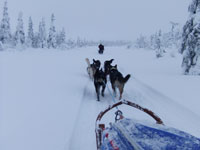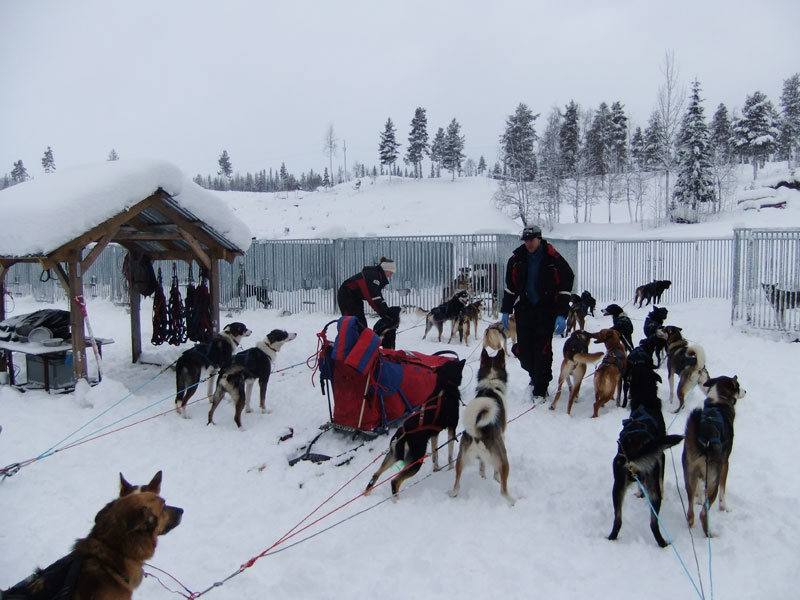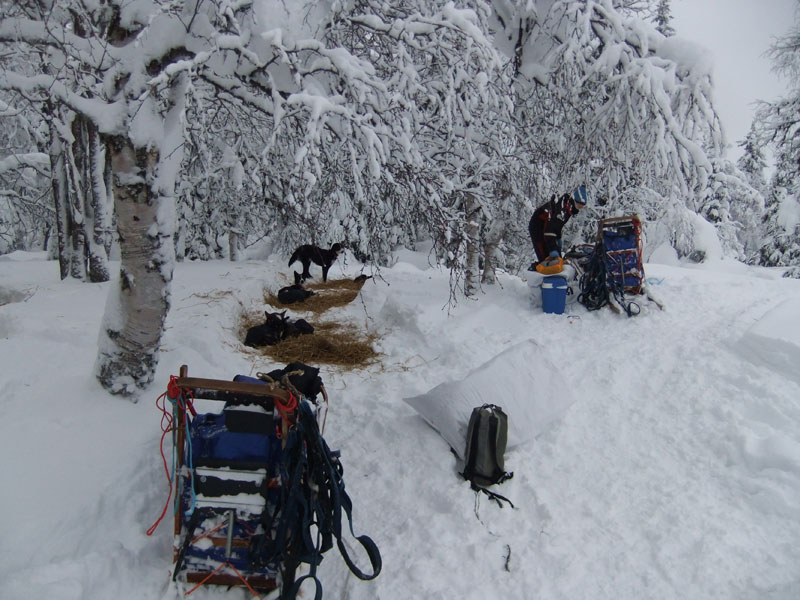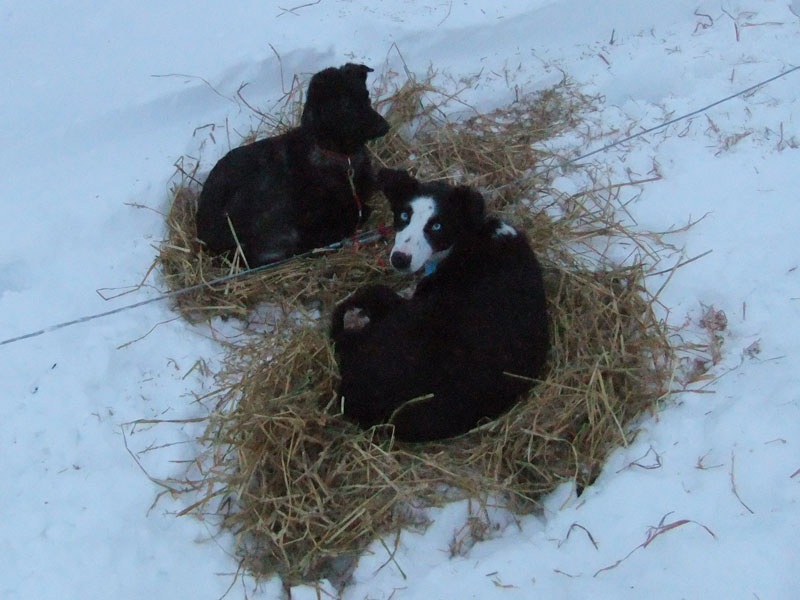
Bob from Nature Travels joined our Dog Sledding and Northern Lights in Vindelfjällen experience for a tour in mid-February.
To misquote Douglas Adams: “Lapland is big. Very big. You just won’t believe how vastly, hugely, mind-bogglingly big it is. I mean, you may think it’s a long way down the road to the chemist’s, but that’s just peanuts to Lapland.”
Ask most people what associations they have with “Lapland” and they may answer “the Ice Hotel” (located in the far north of Swedish Lapland, the region in which many of our dog sledding and also ski touring experiences take place) or perhaps “Father Christmas” (the area of Finnish Lapland around Roveniemi is best-known for Santa-related activities).
But few are likely to say “Vindelfjällen”, tucked away in the little-visited western part of this huge county, and fewer still will know that Vindelfjällen is Europe’s largest protected area, covering over half a million hectares.
So it was to this wild and woolly wilderness that I made my way for our Dog Sledding and Northern Lights in Vindeljfällen tour, a 5-day (sometimes 6-day)* cabin-cabin tour which takes place in the Kirjesålandet reserve, part of the larger Vindelfjällen area.
* Wilderness Dogsled Adventure in Vindelfjällen is an extended 8-day version of the tour, covering greater distances and with a higher level of challenge.

Day 1
Travel to the kennels is by a combination of night train and bus from Stockholm or by domestic flight. As time away from the busy Nature Travels office is very limited in February, against my eco-sensibilities I chose on this occasion to take the flight option, and boarded a very compact and cute-looking turboprop from a quiet corner of the domestic terminal at Stockholm Arlanda airport bound for Hemavan**, best known as a downhill ski area and about an hour or so by car from the kennels.
**Airport transfer for this tour is no longer from Hemavan/Vilhelmina, but is now from Arvidsjaur.
The route to Hemavan touches down in Vilhelmina and, to our surprise, when we landed, the cabin crew looked apologetic and announced that, due to wind conditions further up the route, the flight would be terminating here and onward travel to Hemavan would be by bus.
Oh well, remote travel always comes with a few uncertainties, and a very friendly bus driver was waiting just outside the airport terminal with a welcoming box of soft drinks and reindeer-meat wraps to help us on our way (no vegetarian option available on this occasion, though, so I went hungry!).

Actually, the kennels lie just over halfway between Vilhelimina and Hemavan and we would be passing right by them on the bus, so in the end the inconvenience was minimal, and after dozing our way through the endless forests for a couple of hours we arrived refreshed only a little later than originally planned.
Head guide for the tours is one of Sweden’s most accomplished mushers, a four-time Swedish champion dogsled racer and the top-finishing Swede ever in Norway’s Femundløpet race. If you want to talk huskies, from the importance of nutrition to the finer points of body shape, he’s your man!
We were welcomed into the warmth and hospitality of the kitchen, where our guide’s wife, Angela, was busy rustling up a delicious-looking cake for us to take out with us on the tour (Angela’s cooking was to be a memorable feature of the next few days!).
But before sitting down to dinner there was work to do, and we headed out eagerly for our first meeting with the dogs and to help with the feeding. There are around 50 dogs at the kennels, 25 of which would be following with us on the tour the next morning.

That evening we were issued with the equipment we would need – snowmobile suits, boots, hats, gloves, and a sleeping bag that looked like it would keep you warm in space – before retiring for the night, full of anticipation for the tour ahead.
Day 2
Well-rested and energised by a hearty farmhouse breakfast, we began next morning to pack the sleds and organise our equipment, and finally it was time to harness our teams.
Scandinavia, like much of Europe, was experiencing some very unusual winter conditions, with temperatures much milder than normal. Where it would typically have been around -10 to -15 degrees, temperatures were just a fraction below zero, which had resulted in a considerable amount of snowfall in the days before (more snow tends to fall when temperatures are around zero than when it’s very cold).

Everywhere the trees hung heavy with fresh snow, giving a real “winter wonderland” feeling wherever we looked. This also influenced trail conditions – with so much new snow, the prepared paths had been obliterated and we steeled ourselves for a real trailblazing expedition as we would need to carve a new route through the winter wilderness.
With the going likely to be heavy given the thick snow, I would be running six dogs in my team, two more than normally used. We distributed the harnesses (different dogs have different sizes) and began the work of harnessing our teams.

My lead dogs were two beautiful females with border collie markings – the young and energetic Ariel and the more experienced Sota. Behind them came two other females, November and Luna, and finally my wheel dogs, the boys Avanti and Bronko at the back.
Over the next few days we would be working hard together and getting to know each other very well!
We headed straight out of the kennels and onto the trail and had soon left what little civilization we had started in far behind, entering a magical world of deep forest with branches groaning under the weight of snow.
The snow was so heavy that some branches bent low right across the trail, making the first hour or so a fun obstacle course as we ducked and weaved our way between them.
Soon came the first test of the tour, a steep downhill in very deep snow, and we had terrific fun slithering our way down through the trees but also testing our braking skills! We emerged exhilarated and a little sweaty into a much more open, flat landscape – the first of two lake crossings we would do that day.

These crossings required some thought. With the trail invisible beneath the snowfall, our guide paused, gazing into the distance and scanning the far side of the lake, which was several hundred metres away, carefully, trying to identify the small gap in the trees that we would take once across.
Though there was a metre of ice or more beneath us (enough to support a truck), when the snow is as thick and heavy as it was, its weight pushes the ice layer down so that water rises up above.
While it can be alarming to see the dogs’ paws suddenly sinking into water as you sled across a lake, there’s no cause for concern, but it does make the going tough, and both two and four-footed team members were pleased when we finally made our way across and entered the forest once more.

After a very scenic pause by the river for a late lunch, we pressed on, this time with a climb taking us up towards our cabin for the night. Again, the deep snow added to the beauty but also to the challenge. When going uphill, it’s necessary to step off the sleds and assist your team to move the sled onwards, but when the snow is a metre deep and freshly fallen, this can be easier said than done!
More often than not, we would step off to push, find no purchase, and instead sink to our waists, where we would struggle and thrash until we freed ourselves again – not much help to the dogs! As Vadim cried joyfully from the back, “This is real mushing!”
But that’s all part of the fun, and when we finally crested the top to see a cosy little cabin peeping out from the trees, we knew we were home for the night.
The experience of dog sledding is as much about the enjoyment of working with the dogs, taking care of your team and cabin life as it is about the time spent on the sleds, and although we had reached our destination, the day’s work was far from over.

Once we had cleared the snow from the door and unpacked our gear into the cabin, we turned our attention to our teams.
Unlike many mushers, who bring separate lines on which to stake out the dogs at night, our guide’s method is to stake out the dogs on their sled lines, with extra long neck lines used to give them extra space to maneuver during the night.
His dogs may well be some of the most pampered sled dogs in Sweden, with each getting not just a cosy doggy coat for the night, but fresh straw bedding as well! After feeding, they certainly looked content as they snuggled down for the night as our stomachs told us it was time to think about our own dinner.
Not to be outdone by Angela’s baking skills, our guide had arranged a real feast for us for the main course, bringing along some fresh brown trout recently caught by a friend in the pure local waters, which he set to work frying outside with his own secret mushroom sauce recipe as the sky darkened and night drew in.

Whatever it was, it tasted delicious! Vadim prepared his trademark potato dish, which complemented the fish perfectly.
With full stomachs, glad hearts, and minds reeling with the impressions of the day, we crawled into our sleeping bags and slept like babies.

Day 3
We’d need our energy for the next day, as we were heading upwards above the treeline to the “kalfjäll”, the wide sweeping mountain plains characteristic of this part of Lapland.
With the snow so deep, we were going to need some help to be able to sled into this area, so our guide had kindly enlisted the assistance of his uncle, who came by snowmobile to meet us at breakfast and headed off to pack down the trail that we would follow for sledding that day.
Though the going was still quite tough, having a trail made all the difference, and we had a wonderful morning sledding through the wilderness, gradually getting higher.
Although the low cloud cover meant that the Northern Lights would be elusive on this trip, it created a magical “whole world to ourselves” atmosphere, shrinking our focus from the enormity of the landscape around us and focusing our attention on the beauty of the world closer to hand – the endless variety of the snow sculptures on the surrounding trees, the perfect silence save for the pat-pat of our teams’ paws on the trail and gentle glide of the sled.
As with any winter activities in the Swedish wilderness, when dog sledding in Lapland you quickly come to appreciate the subtle differences of the shifting landscape – first impressions might be “it’s all just trees”, but with a little time you see that each area has its own charm and is constantly changing – a particular loveliness in the curve of a hill here, an especially attractive clump of boulders there.
There was one section that felt so magical and otherwordly that I found myself having to choke back a lump in my throat at the monochrome beauty of it all. Fortunately I had my goggles on, so was able to give into the sentimentality of my inner world while maintaining a suitably “macho” exterior!

We passed through the treeline into the open plains and began the last push for the summit. Even with the snowmobile trail to help us along, this last section was a challenge, and I found myself sinking time and time again deep into the soft snow.
Out in front my dogs pushed on valiantly, tails still wagging and clearly finding the whole thing enormous fun, just turning round occasionally to give me a reproachful look when they felt I wasn’t helping as much as I should (it may have just been a trick of the wind, but I’m sure I heard them saying to each other, “What, has he managed to get us stuck AGAIN?!”).
Finally we reached the top, with the wind barely a whisper and the wide sweep of Vindelfjällen spread out beneath us.
The weather was maybe not quite clear enough for us to appreciate the full majesty of our location and the scale of the wilderness surrounding us, but what we could see still took our breath away and lunch was a quiet and contemplative affair as we took in the view.

The afternoon took us down once more into the trees and to a second cabin for the night, this one a little larger than the previous evening but no less cosy.
We were in good spirits following a wonderful and adventurous day, and we rounded it off with a competitive but good-natured few hands of Uno before taking to our sleeping bags once more.
Day 4/5
The next day, our last on the sleds, took us homewards towards the kennels, a combination of new discoveries and retracing some of our route from the first day.
We arrived tired but very happy in the afternoon, and with more than a little wistfulness that our adventure was over, began the process of unpacking our equipment and giving our dogs some last snacks and hugs.

But another of Angela’s wonderful farmhouse dinners went a long way towards keeping our spirits up, before a final night at the kennels and transfer to Hemavan the next day for our departure.
I have been lucky enough to participate in many dogsled tours as part of my work with Nature Travels. I love dog sledding and have never failed to enjoy the beauty of the mountain and forest landscapes, the joy of running your own team and getting to know the dogs, the many little tasks around the cabins, the camaraderie of sharing an outdoor adventure with guests from all over the world, and the rewarding challenges posed by different terrain and varying conditions.
But on Dog Sledding and Northern Lights in Vindelfjällen, I felt a very special sense of uniqueness and privilege, of being welcomed into the daily life of my hosts and their families, of taking part in a sledding adventure that is very much “off the beaten track” and very much an authentic mushing experience.
Roll on next winter!
Bob from The Nature Travels Team.
